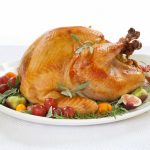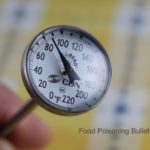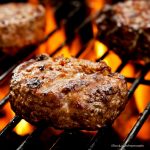With the holidays approaching, it's important to keep food safety in mind. One of the best ways to ensure that the food you make and serve is safe to eat it to use a food thermometer. But do you know how to use a food thermometer correctly? First, you should know that there are several types of food thermometers. The most inexpensive and common is a dial thermometer. This has a dial on a stem that is attached to a probe. You can find these thermometers are most grocery stores. This thermometer is not always the most accurate, but it will give you a general reading. The second type is an oven-proof thermometer that you use while the food is cooking. A probe goes into the meat roast or whole chicken or turkey, then a cord extends outside the oven to the dial that shows … [Read more...]
Follow Thanksgiving Food Safety Steps from the CDC For a Safe Holiday
The CDC is offering Thanksgiving food safety steps for you to follow as you prepare this holiday dinner to stay safe. This Thanksgiving will be different, with fewer large gatherings and more people staying home to protect themselves against Covid-19. So avoid food poisoning, which is a major risk during the pandemic, with these tips. First, keep it clean. Always wash your hands with soap and water before you start to cook and eat. Make sure that food preparing surfaces and utensils are clean and sanitized before you start to cook. Think about sanitizing the sink and countertops before you bring out the food. You can use a commercial product or make your own by mixing 1 tablespoon liquid chlorine bleach with one gallon of warm water. For meal prep, make sure that you keep raw … [Read more...]
Food Thermometer Study Proves Education Improves Kitchen Food Safety
A food thermometer study conducted by the USDA's FSIS and published in the Journal of Food Protection in July 2020 proves that education improves kitchen food safety techniques. The purpose of the study was to test effectiveness of intervention for consumer thermometer use. Using a food thermometer is the only way to make sure that ground meats are safe to eat before serving. Ground beef, pork, and lamb should be cooked to 160°F and ground chicken and turkey should be cooked to 165°F. USDA's Under Secretary for Food Safety, Dr. Mindy Brashears, said in a statement, "As a food scientist, it’s important that we publish these results in peer-reviewed journals and that other scientists have access to the methodology and results. This is in direct alignment with my goal to lead food … [Read more...]
Fourth of July Food Safety Tips From the USDA to Avoid Illness
These Fourth of July food safety tips from the USDA will help you avoid foodborne illness this holiday weekend. Because more people are staying at home and cooking at home, these tips are important. Dr. Mindy Brashears, the USDA's Under Secretary for Food Safety said in a statement, "Foodborne illness can increase during summer because of the warmer temperatures and extended time spent outside. You may not be grilling at the park this year, but instead you may be grilling at home. As we celebrate this Fourth of July holiday, I encourage consumers to use food safety steps to reduce their risk of illness." First, avoid cross-contamination between raw meats and poultry and foods that are eaten uncooked. Wash and sanitize all surfaces and utensils after they touch raw meats and … [Read more...]
Study Finds Common Chicken Doneness Tests Not Effective
A study published in Plos One has found that common chicken doneness tests are not enough to ensure that pathogens in the bird have been destroyed before it is served. The study was conducted among 75 households in Europe from five countries. Researchers wanted to investigate whether actual and recommended practices for monitoring chicken doneness are safe. And a cross national web survey collected cooking practices for chicken from 3,969 households. Chicken is often contaminated with Salmonella bacteria. There have been many outbreaks linked to improperly cooked or undercooked chicken in the past few years. In a lab kitchen, chicken breast fillets were injected with cocktails of Salmonella and Campylobacter, then cooked to core temperatures between 55°C (131°F) dnd 70°C (158°F). … [Read more...]
New Study Finds Canadian Cookbooks Don’t Provide Food Safety Info
A new study, published in Food Control for June 2019, finds that meat and seafood recipes in some popular Canadian cookbooks do not provide adequate food safety information. The authors included 19 cookbooks that focused on meat and seafood. The study was conducted at the Canadian Research Institute for Food Safety in the Department of Food Science at the University of Guelph in Ontario. The evaluated cookbooks were published from 2015 to 2017. In 2017, another study published in the British Food Journal found the same thing; no food safety information or incorrect info. Overall, the study found that "cookbooks are not a good source of reliable food safety information or safe food handling practices, and they do not encourage the reader to practice safe food handling during … [Read more...]
It’s Important to Use a Food Thermometer so the Food You Serve is Safe to Eat
Michigan State University has issued a post telling consumers that using a food thermometer is easy and important for your family's health. Most people don't use a food thermometer when cooking. Although about 62% of American consumers have a food thermometer in their kitchens, fewer than 10% actually use it. Any food that contains meat, poultry, fish, or eggs should be tested with a food thermometer before it is eaten to make sure that food has reached a safe final internal temperature. Using a thermometer is the only way to know that your food is thoroughly cooked and that it has reached a temperature that will destroy pathogenic bacteria. If your family has a member who is in a high risk group for food poisoning, this cooking step is even more important. Those in high risk … [Read more...]
USDA Says Grill Like a PRO
The USDA is offering tips on how to "Grill Like a PRO" this summer. That means using a thermometer to check the internal temperature of meats and poultry before you serve them. Research by the USDA and FDA found that only 24% of the public use a food thermometer when cooking hamburgers, and only 42% do so when cooking chicken. There have been many food poisoning outbreaks over the past few years linked to contaminated ground beef and chicken. Using a food thermometer is the only way to keep you and your family safe from food poisoning. P - Place the Thermometer! Put the thermometer probe into the thickest part of the meat. The probe should go in about 1-1/2 to 2". If you are cooking a thinner piece, such as hamburgers or chicken breasts, insert the thermometer from the side. Make … [Read more...]
Common Kitchen Food Safety Mistakes
Researchers at Institute of Food Technologies have released information on the five most common food safety mistakes consumers make in their kitchens. The team videotaped 120 consumers as they prepared a chicken and a salad at home. Most consumers felt they were handling and cooking the food correctly, but many made critical mistakes. The first was not washing hands before starting to prepare food. Hands should be washed with soap and water for at least 20 seconds before starting to cook, and dried with a paper towel, not a cloth towel that can become contaminated. The second mistake was washing chicken. When chicken is washed under running water, the bacteria aerosolizes and spreads up to 3 feet away. The bacteria then ends up in the sink and surrounding countertops, and some may … [Read more...]
Food Processors, Food Safety, the Law, and Common Sense
After the announcement of the Foster Farms raw chicken Salmonella outbreak, we realized there is a lot of misinformation out there about what contamination of food by pathogenic bacteria really means, both physically and legally. Reading comments on some other news stories really brought this point home. Most people do not understand why food safety experts and the law stress that food processors must produce safe food. The law states that companies are not allowed to sell food contaminated with enough bacteria to make someone sick. In addition, there is zero tolerance for several bacteria in certain foods: E. coli O157:H7 in beef; Listeria monocytogenes in ready-to-eat foods, and Salmonella in ready-to-eat foods. The government has also classified six other STEC (shiga toxin-producing … [Read more...]












